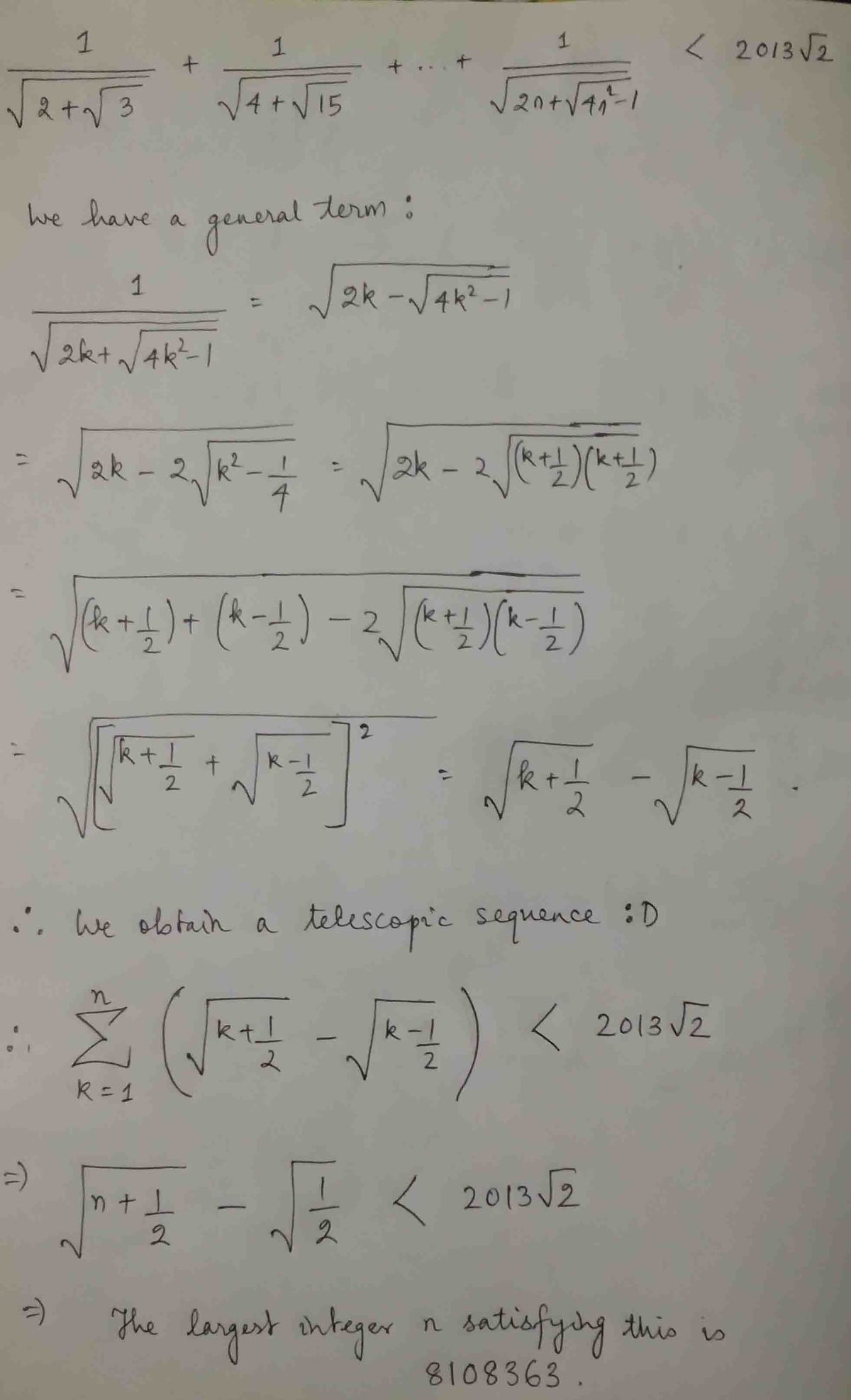Find the largest Integer, without programming!
2 + 3 1 + 4 + 1 5 1 + … + 2 n + 4 n 2 − 1 1 < 2 0 1 3 2
Find the largest positive integer n such that it satisfies the inequality above.
The answer is 8108363.
This section requires Javascript.
You are seeing this because something didn't load right. We suggest you, (a) try
refreshing the page, (b) enabling javascript if it is disabled on your browser and,
finally, (c)
loading the
non-javascript version of this page
. We're sorry about the hassle.
3 solutions
Moderator note:
Simple standard approach with telescoping sums.
How can one tell that the LHS allows for a nice telescoping sum?
Overrated, seriously!
Though, I have solved many questions like this where a bizarre looking expression telescopes to a simple number, but, everytime I have to write at least three to four terms from beginning and end so as to recognise the fashion in which term cancels. So, I want to know, is there any technique by which we can ascertain in advance that a series having the general term as difference of two terms telescopes to a certain number and if it is then to what number it telescopes ? Any response will be greatly appreciated !
S = 2 + 3 1 + 4 + 1 5 1 + . . . + 2 n + 4 n 2 − 1 1 S = 4 + 2 3 2 + 8 + 2 1 5 2 + . . . + 4 n + 2 4 n 2 − 1 2 (Multiplying numerator and denomiantor by 2 in prev step) S = 1 + 3 2 + 3 + 5 2 + . . . + 2 n − 1 + 2 n + 1 2 S = 2 2 ( ( 3 − 1 ) + ( 5 − 3 ) + ( 7 − 5 ) + . . . + ( 2 n + 1 − 2 n − 1 ) ) We obtained the last step by taking 2 common and rationalizing all the terms.
We proceed by noticing that it is a telescopic series, so all terms cancel except 2 n + 1 and − 1
S = 2 1 ( 2 n + 1 − 1 ) < 2 0 1 3 2 (Given) 2 n + 1 − 1 < 4 0 2 6 2 n + 1 < 4 0 2 7 2 n + 1 < 1 6 2 1 6 7 2 9 2 n < 1 6 2 1 6 7 2 8 n < 8 1 0 8 3 6 4
Answer is 8 1 0 8 3 6 3
Moderator note:
Simple standard approach.

Let S = L H S , then we have:
S = k = 1 ∑ n 2 k + 4 k 2 − 1 1 = k = 1 ∑ n ( k + 2 1 ) + ( k − 2 1 ) + 2 ( k + 2 1 ) ( k − 2 1 ) 1 = k = 1 ∑ n ( k + 2 1 + k − 2 1 ) 2 1 = k = 1 ∑ n k + 2 1 + k − 2 1 1 = k = 1 ∑ n k + 2 1 + k − 2 1 k + 2 1 − k − 2 1 = k = 1 ∑ n ( k + 2 1 − k − 2 1 ) = k = 1 ∑ n k + 2 1 − k = 1 ∑ n k − 2 1 = k = 1 ∑ n k + 2 1 − 2 1 − k = 1 ∑ n − 1 k + 2 1 = n + 2 1 − 2 1
⇒ S = n + 2 1 − 2 1 ⇒ n + 2 1 n + 2 1 n ⇒ n < 2 0 1 3 2 < 2 0 1 3 2 + 2 1 < 2 0 1 3 2 ˙ 2 + 2 ˙ 2 0 1 3 2 ˙ 2 1 + 2 1 < 2 ˙ 2 0 1 3 ( 2 0 1 3 + 1 ) = 8 1 0 8 3 6 4 = 8 1 0 8 3 6 3